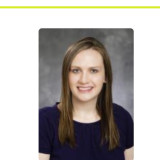It seemed to me, after all the years of hard work, that medicine was asking for too much. I knew from the outset that demands on my time would be made. Everyone warned me about it, so it was more uncomfortable than it was surprising. I was finishing the fourth and final year of my ob/gyn residency and while I knew I had chosen the right specialty, I felt weary about how much time I had been required to give — specifically, time away from my two little babies. I felt I had missed a lot of the first 18 months of their lives.
So it was that I started to practice with my guard up. I was happy to treat patients that needed care, willing to do the work that was asked of me, and, as a quintessential rule follower, wanted to meet every goal set in front of me. That was it, though. Nothing more. I didn’t want to work harder or cover extra shifts or do moonlighting calls for extra money. The only thing I wanted was for my time outside of work to be mine, and mine alone. I continued along in this mindset for years. Then, something changed.
As with many of the women I have cared for during their pregnancies, I had known Laura for years. I saw her for annual exams and excitedly discussed her wedding plans and new marriage, as well as her struggles to become pregnant. Her much-awaited baby grew well throughout her pregnancy and we spent her prenatal care visits discussing not only her baby preparations, but also her work, family, friends, and daily life concerns. Near her due date, she decided on labor induction for her delivery; we set a date for Laura to arrive at the hospital.
In obstetrics, we are present for one of the most significant moments in our patients’ lives. In a large group practice (and even in many smaller practices), it is not always practically feasible to attend the delivery of every patient we see for prenatal care. That said, I felt comfortable knowing that my trusted partners would be taking care of my patients when I was at home with my family or doing other work.
As Laura got closer and closer to her due date, an upheaval was happening. A global pandemic was ongoing, but in my personal world also the people I relied on at work were finding new jobs, necessitating new hires. Almost nothing at work was the same. The standard ebbs and flows of good and bad events became more like a rollercoaster with greater heights and bigger drops. I handled it the only way I knew how: I focused on my patients, who were now possibly the only reliable element of my job.
With her induction approaching, I told Laura I would be present for her delivery. What I meant was that I would specifically arrange my schedule to make sure I could be there for the birth of her baby. The truth was, I was willing to give a bit more because, with Laura, I felt something more. There will always be people who need help, and I will always be one of the people able to provide that help. But with Laura, I began to see that it was not just what I did but how I did it that made the difference in what it felt like to be at work.
The delivery was challenging. Her baby did well, but Laura herself experienced a postpartum hemorrhage and needed follow-up testing. She told me later how much it meant to her that I was there, that my presence was not merely appreciated, but made her feel that, even when the situation seemed scary, everything would be OK.
In the past, I was scared to care more because I feared it would complicate things. If I went to the hospital specifically to do a delivery, I might have to deal with an unexpected problem. If I volunteered for extra work, I might be volunteering for extra challenges. It was both the fear of the unknown and the risk of challenges that kept me from offering more of myself to my job. I would tell myself that I was helping the people I needed to help; I would tell myself I wasn’t doing anything wrong — and really, I wasn’t. But I was also holding back.
In medicine, we are accustomed to the setting of goals, benchmarks, and standards. In clinical practice, there may be set production numbers (RVUs or number of patients), or various clinical practice goals: are we screening a certain percentage of people for depression? Has everyone had their colonoscopy? How many Press Ganey stars have we earned and how can we increase them? We started from a place of striving to be better than the best in medical school and residency, and moved into practice with that mindset. Metrics are important, of course, and objective measures of quality can lead to better care for patients. The definition of success, however, is arbitrary, and the definition we end up using may not truly reflect what a patient needs from their clinician.
Sigmund Freud once said, “One day, in retrospect, the years of struggle will strike you as the most beautiful.” What he meant is that our ability to identify and solve problems is ultimately what leads to our fulfillment in life. While patients certainly aren’t problems to be solved, our ability to help, in addition to our willingness to let our hearts be a part of the process, can open us up to a different level of happiness.
Changing my aims to include both clinical goals and deeper relationships with my patients has highlighted something: without struggle, there is no strength. Without challenge, there is no growth. And, in the words of musician Mike Posner in the song “Be As You Are,” “Life is better when you open your heart.” Boundaries should and do exist. Work is, in fact, still work and we are all much more than our job. It is important, truly, to strike a balance between our careers and our lives outside of the services we provide. I would posit, though, that the depth of care we provide improves not only who we are as clinicians but who we are as people. The things that are worth achieving may not always be measurable. We may need to walk through fire and risk getting burned, but doing so gives us the opportunity to see previously intangible rewards, if only we’re willing to open our eyes.
How much of your head and heart do you give to your work? Are you a 50-50 clinician, or more of a 70-30? Share your perfect ratio in the comments — there are no wrong answers!
Jill Moes is an obstetrician/gynecologist working in St. Paul, MN. She loves fireworks, weddings, books, thinking about life, and trying to keep up with her three busy boys. Dr. Moes is a 2021–2022 Doximity Op-Med Fellow.
All names and identifying information have been modified to protect patient privacy.
Illustration by Jennifer Bogartz







